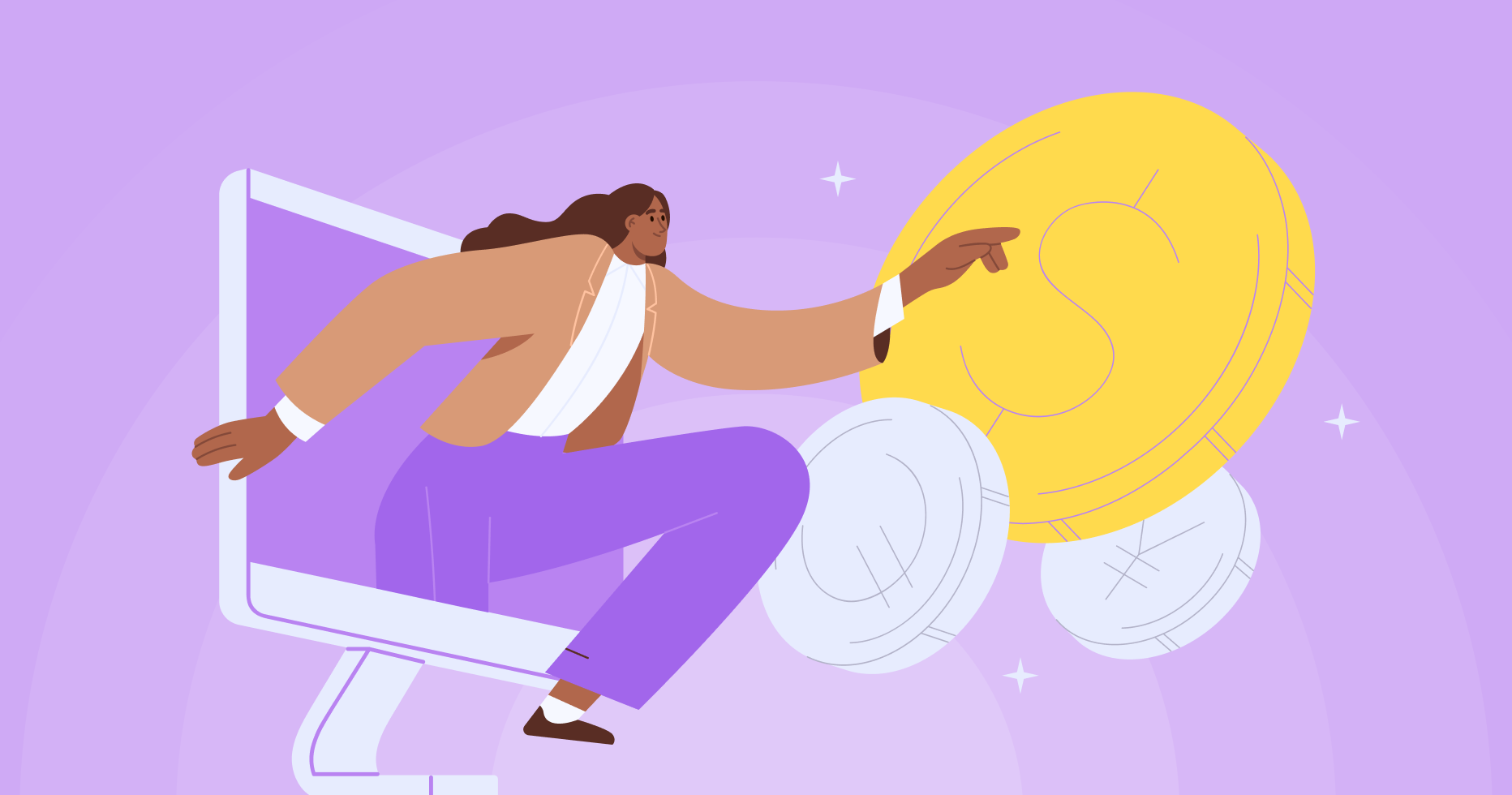In this article, we’ll discuss the main ways to earn money from a personal blog, as well as how much you can expect to make. Our focus will be on the travel niche, but what you learn here also applies to other parts of the blogosphere.
Can you (really) make money from blogging?
With 50% of bloggers treating their blog as a full-time job, the answer is clearly yes. But your income will depend on many factors, such as niche, audience, monetization strategy, and more. There’s a huge range – bloggers report anywhere from $500 to over $100,000 per month.
The travel niche has remained resilient and profitable in recent years and keeps attracting aspiring bloggers. If you put in the work, you can aim to make at least $1,000–$2,000 every month by following firsthand tips from travel bloggers.
Travel bloggers come from all walks of life. For example, Jackie of Jou Jou Travels went from working as a digital analyst to earning a five-figure income with her travel blog during the pandemic. Her favorite monetization strategies include affiliate marketing, ads, sponsored posts, and more. Jackie also pays special attention to SEO, diversifying traffic, and carefully analyzing data.
Isabel of Bel Around the World is another travel blogging sensation who’s now earning over $10,000 per month. The majority comes from sponsored posts, Mediavine, and affiliate marketing.
Whether you can make money on a blog depends not so much on your current skills (you can learn on the go) as on the time and effort you’re willing to invest in creating and running your blog. You will need to produce new content consistently in order to attract an audience from which you will later earn money. The payoff won’t be immediate, and you’ll need to be patient and systematic.
How much money can you make from a blog?
How much money you can potentially make from a blog depends on many factors, but the key ones are:
- Total traffic volume
- Traffic quality
- How you monetize your traffic
Later, we’ll talk about each factor in detail, but in short, you need as much traffic as possible, especially traffic consisting of people who are ready to make purchases (or very close). When it comes to monetization, you can simultaneously combine several methods, such as affiliate marketing and contextual advertising.
There is no universal formula for how much you can earn, but $25 to $30 per 1,000 ad impressions is reasonable for U.S. traffic. For other regions, you can expect several times less.
Who can make money blogging?
Some people approach their blogs as hobbies or side projects, others as full-time jobs. Most bloggers begin with a combination of regular work and blogging as a hobby, and some later transition into full-fledged blogging.
Gabriele, the creator of Thelithuanianabroad.com, is one example; she lives entirely on income from her blog. You can learn more about her travel blogging journey here.
The unsurprising rule is this: the more time you spend working on your blog, the faster it will start bringing high levels of income. This is why hardworking bloggers who view their blogs as their main project usually earn more than hobbyists.
How to make money blogging in 8 steps
In general, the more traffic you have, the more you can earn, but there are also ways to make money that don’t require traffic. Below, we’ll look at both kinds of techniques.
1. Sell links
Even if your website has little or no traffic, you can start monetizing it by selling links. Google and other search engines rank websites based on various factors, including the number of pages that link to them. For that reason, other sites are willing to pay you for link placement.
Links in blog posts usually involve a one-time fee, while links in the interface – in the footer or menu – are often rented.
A single link can cost between $50 and $500, depending on your domain authority (DA). You can check this through services such as Website SEO Checker:

Buyers are only willing to pay a lot for links from domains with a high DA rating (50 and above). If you are unsure how much you can charge, use platforms such as Small SEO Tools to calculate the price.
A word of caution: Google frowns on paid links since they prevent it from properly estimating the value of websites.. Therefore, if you go the paid-link route, do it sparingly.
2. Write guest posts
Another way to monetize your website is through guest posting, or guest blogging – writing content for other websites to promote your brand and get a backlink. Since the number of backlinks affects how search engines see the website’s authority, guest posting is a popular strategy in the blogger community.
You can make money through guest posting directly, by accepting paid guest posts on your website from contributors, or indirectly, by posting on other sites and driving traffic back to your blog.
To make money fast, consider accepting posts from guest writers. The price will depend on various factors, such as your DA and traffic volume – the higher the numbers, the more you can charge. Another factor is the ratio of outbound links to the number of indexed pages. A site with 10 links will be able to sell a link for more than a site of the same size with 900 links.
Alternatively, by sharing guest posts with a backlink on other websites, you can eventually grow your audience and brand exposure, as well as build credibility and establish yourself as an expert. This will not only drive more traffic to your website and boost income through ads and affiliate marketing, but can also increase your domain ranking. In this regard, guest posting is a valuable long-term strategy to grow your blog and build meaningful relationships.
3. Try affiliate marketing
By recommending a trusted seller or product to your audience, you can earn a commission on each sale. This approach to earning is called “affiliate marketing” and works as follows:
- You choose brands (companies) to partner with – ones your audience might be interested in that you are also ready to recommend. For example, if you personally used the GetYourGuide service while traveling, you can join the GetYourGuide affiliate program and recommend their services to your audience.
- The brand provides you with affiliate tools, such as special links and interactive widgets, which you can use to send traffic from your site to the brand’s site.
- You place affiliate tools on your blog. For example, when you write an article about Barcelona, you can recommend a specific brand that sells tours or museum tickets.
- Your audience reads an article on your website and follows your recommendation to the brand’s website.
- The brand records that it was your tool that brought a person to their site.
- The person you referred makes a purchase, and you earn a commission on that sale.
It’s important to note that if users don’t make a purchase, you typically don’t get a reward. The exact amount of the remuneration and other conditions depends on the brand. Here are some examples:
| Brand | Commission |
| Booking.com | 4% |
| Viator | 10% |
| Rentalcars | 6% |
| Busbud | 5% |
| Insubuy | Up to $150 |
| Go City | 3.4–6% |
| Flixbus | Up to 5% |
| Agoda | 6% |
| Trip.com | 1–5% |
The basic idea is the same across all niches. On this page, we’ve collected the most popular affiliate programs from various industries, including education, health, and finance.
Now you understand what Travelpayouts does: we’re a platform that connects bloggers with brands. In fact, we’re the world’s largest travel partnership platform, with over 100 travel affiliate programs, from huge brands such as Booking.com, GetYourGuide, and RentalCars.
Every month, Travelpayouts partners receive hundreds of thousands of dollars, and in total, partners have earned over $40,000,000.
Join the Travelpayouts partnership platform
Join today4. Host advertisements
Besides affiliate marketing, there are some other types of advertising that you can place on your blog and earn money from. These include:
- Contextual advertising
- Direct advertising
Let’s take a closer look.
Contextual advertising
With this method, you don’t need to look for advertisers, negotiate terms, etc. You just place ads on your site in a few clicks by connecting to contextual advertising networks. It works like this:
- Choose the right contextual advertising network for you, such as Google Ads, Ezoic, Mediavine, etc.
- Register for the network.
- Pass the moderation process for your blog (most networks request minimal traffic and high-quality content on the site).
- Get a code for integration on your site.
- Embed the code in places on your site where you want ads to be displayed.
- The network displays ads there.
- You get paid for clicks on ads (and, less often, for ad impressions).
Your site will then have a variety of ads that will either match the context of your page or the interests of your users.
The advantage of contextual advertising is that you receive guaranteed income per click. It doesn’t matter to you if the person who clicked on the ad bought something or not; you will receive a few cents per click in either case. However, this can also be a disadvantage. If a person bought, for example, a tour in Barcelona, you could have earned a healthy percentage if you’d been working with the affiliate program.
Therefore, if you have a high-quality site whose audience is close to making an actual purchase, you should first look at affiliate marketing. With the right choice of product (one which the audience needs), the chance of earning a decent payout is high.
Direct advertising
This method only works well if you’re a leader in your niche. Finding advertisers that will work directly with small blogs can be tough, as they often prefer to work through contextual advertising networks.
For large sites, though, this is the better option not only in terms of income, but also better in terms of formats. Direct advertising can be manually integrated or implemented in an organic way as part of a special project.
How much you can earn from direct advertising depends entirely on your niche and overall traffic, as advertisers pay based on the number of impressions you generate.
5. Offer paid subscriptions
If you want to get consistent revenue from your blog and build a thriving community, it’s a good idea to offer premium content through paid subscriptions. Let’s walk through what a subscription revenue model is, what benefits it offers to travel bloggers, and how to make money with paid subscriptions on your website.
Paid subscriptions are a revenue model that allows bloggers to charge their subscribers a recurring fee in exchange for access to premium content on their blog. This model is based on building long-term relationships with customers and benefits both parties. On the one hand, companies get recurring income and save on acquisition costs by keeping their readers close. On top of that, membership sites are easily scalable and allow you to boost profits as you sell more subscriptions. For their part, customers enjoy access to premium content for a low ongoing fee and become a part of a like-minded community.
To make money with paid subscriptions, make sure to follow these steps:
1. Set up recurring subscriptions
With a median subscription price of $49, you are missing a great income source by giving away your content free of charge. You can offer membership options based on payment frequency (for example, from weekly to yearly memberships) or access level. Higher-tier members can get more perks, such as ad-free experiences, coaching, free downloads, priority support, and more.
2. Build a community
Once new subscribers get behind the paywall and access premium content, they’ll most likely also expect to be part of your community. Make sure to encourage participation by running challenges, setting up live webinars, offering rewards, and celebrating your members’ achievements. Another great way is to run live webinars and answer questions in real-time.
3. Reduce member churn
If you notice signs of potential churn (subscribers falling away), make sure to try and re-engage your members. This could mean reaching out in person, setting up an automated email sequence, running a survey, or even offering a discount. For example, Coursera offers a 50% discount on its Plus Membership after a member decides to cancel their subscription.
4. Build a membership app
The ultimate goal of any membership site owner is to become top of mind for their subscribers. To encourage them to create a habit around your content, consider building an app. This will allow readers to access your content on the go, make in-app purchases, receive push notifications, and more.
6. Sell digital and physical products
Once you’ve built a name and authority in the niche, it is time to monetize it through selling products. This is one of the most popular monetization strategies among bloggers, as it allows them to stay independent of third-party platforms and trends. Selling digital products is also an entry point into the subscription model.
So, what kinds of digital and physical products can you sell on your website?
Ebooks
If you have a lot of relevant content on the same topic, you can gather it in one digital guide. The market of ebooks is expected to generate $15.33 billion by 2027 with the U.S. as the biggest market. Depending on the niche, your book might be a travel guide, lifestyle guide, or how-to instructions. Make sure to add exclusive content that isn’t available to the public. Established bloggers like Somto of SomtoSeeks also publish their own print books.
Online courses
For some creators, creating online courses has become a full-time job. The market for courses is expected to reach $69.02 billion by 2028 with 1 billion users by 2028, the biggest share of them in China.
To create a successful course, start by clearly defining your target audience and what topics they need most help with. To increase your course value, offer community access.
For example, Bri of Bucketlist Bri monetizes her content by selling an online blogging course. It has two price points depending on how much personal support is needed. You can learn more about Bri’s other monetization strategies in her interview with Travelpayouts.
Somto of SomtoSeeks also makes money online by selling online courses. She shares her expertise on how to create a blog bootcamp, grow traffic on Pinterest, become a full-time blogger, and more.
Merchandise
If you’re ready to invest in production, you can also sell branded merchandise: think T-shirts and other apparel, coffee cups (especially reusable ones), home goods, and stationery. Consider your target audience and invest in good design.
7. Write sponsored content
Sponsored content is are articles or posts that brands pay bloggers to write and share. This allows companies to reach wider audiences, increase their brand awareness, drive more traffic to their pages, get more leads, and ultimately boost their revenue.
There are many cases when partnering with a blogger or influencer can be good for a brand:
- When a new company enters the market and wants to spread the word.
- To reach a new audience or boost brand awareness in general.
- After launching a new product or feature.
- For cost-efficient digital marketing, running ads might be more expensive than sponsored content, and posts from influencers can actually be more persuasive.
To land your first sponsored post, make sure to create high-quality content and grow your audience. Whether you run your own blog or are building a presence on social media, it is important to establish authority and boost your brand awareness.
It’s a good idea to create a “Sponsorship” page on your website. There, you can share general information on how brands can order a sponsored post from you and maybe even share your pricing. Make sure that the page is easily accessible from your homepage. Another way is to create a media kit with all the different services that you offer.
8. Provide consulting services
Last but not least, you can also earn by providing coaching and consulting services. The higher your authority and the bigger the audience, the more likely you are to land such an offer. One-on-one coaching is beneficial when customers want a strategy for growth, personalized support, and accountability in reaching their goals.
First, create a dedicated page on your website and explain in detail what your coaching includes. Make sure to indicate the length of each session, content, materials that your student will get, and additional perks that might make your offer more exciting. Since the number of bloggers is constantly growing, make sure to indicate how your offer is unique and helpful to your target audience.
Some bloggers, like Bri of Bucketlist Bri, offer consulting as part of their online course. This helps showcase the benefits of coaching and can lead to direct requests.
How to attract traffic to your blog
We’ve reviewed the main methods for making money from blogging, but you’re probably still wondering how to attract more traffic, since that’s what allows you to earn the most.
The main sources of traffic for any website are:
- Organic traffic (for example, people who find you on Google)
- Direct visits (when people return to the site on purpose)
- Links on other sites (for example, Q&A platforms such as Quora)
- Links from social networks
- Email newsletters
- Paid advertisements
For most blogs, organic traffic is the top source.
How to attract quality organic traffic
For high-earning blogs, both the amount and quality of traffic (how close your readers are to your target audience) are important. Therefore, it is essential to focus on the search queries of people who are close to buying goods or services. Advertisers are willing to pay more for such traffic, and you can also earn more.
To find topics to create content about, you can use the following tools:
All of these are paid tools, but worth the money spent, as they will allow you to find high-traffic topics that you can write about with the aim of reaching the top of the search results. As a free alternative, you can try Google Trends; however, this tool won’t provide you with all the data you need to create high-performing content.
Once you have chosen a topic, you need to study competitors who have previously written content about it. If there are none, congratulations! The traffic is yours for the taking.. However, chances are you do have some competitors, and your task is to make your content at least as good as theirs. Aim to make your posts roughly the same length as those of your competitors and answer the questions being asked clearly and elegantly.
After publishing a new page, it’s a good idea to track exactly how that page ranks in search engines. Again, you can use SEMRush or Ahrefs. If, after about three to five months, the article doesn’t reach the top 10 search results, then study what exactly your competitors have done better and make adjustments. This may require you to:
- Improve your existing content: Your competitors’ content may be more pleasing to readers, to Google’s algorithms, or both. Study their pages: are they using more images or tables? Are their posts more personal and exciting? Find elements that impress you and incorporate them into your own blog.
- Niche down: You may need to narrow the focus of your article. If your topic is broad, you can split the post into two or three and address user questions in detail on each of those pages.
- Get links: As we noted earlier, buying and selling links is a common practice. However, you can also get links organically: for example, you can exchange links with other bloggers for free or simply answer questions on forums and leave a link to your site.
To attract a high volume of traffic from search engines, you should also work to improve the trustworthiness of your site. This applies not only to links, but also to your “About me” page. It’s important that search engines, not to mention your readers, understand that you’re an expert in your niche.
For more information on how to drive traffic to a site where you can earn a solid income, see our free course.
Can you make money from a personal blog?
We hope that the examples of real bloggers have proved to you that yes, you can make money from blogging. We also hope that our detailed review of earning methods and overview of how to get traffic has pointed you in the right direction.
To summarize:
- Blogging is a job from which you can actually make a lot of money. The more time and effort you invest, the better your results will be. However, you should not expect quick results.
- Making money on a blog is possible even without an audience, but doing so is limiting and risky.
- To earn a decent profit, you need to work on growing your website traffic, as the more traffic you attract, the higher your earnings will be..
- Since more and more bloggers are getting in the game, it’s important to decide from the very beginning what your unique value proposition is and how you can appeal to your target audience.
- You need to keep in mind not only the volume of your traffic, but also its quality. The closer your audience is to making a purchase, the more you can potentially earn.
- Affiliate marketing is a great monetization method for everyone involved. You get revenue, your audience gets the best services, and brands get new clients. You can work in the travel niche (for example, through Travelpayouts) or elsewhere.
- In addition, you can earn by selling sponsored content on your blog or social media, running online courses, selling ebooks, or even merchandise.
- If you feel that you have gathered enough authority, consider offering coaching services, either standalone or as a part of your online courses.
Best of luck on your blogging journey, and please let us know if you have any unanswered questions!





